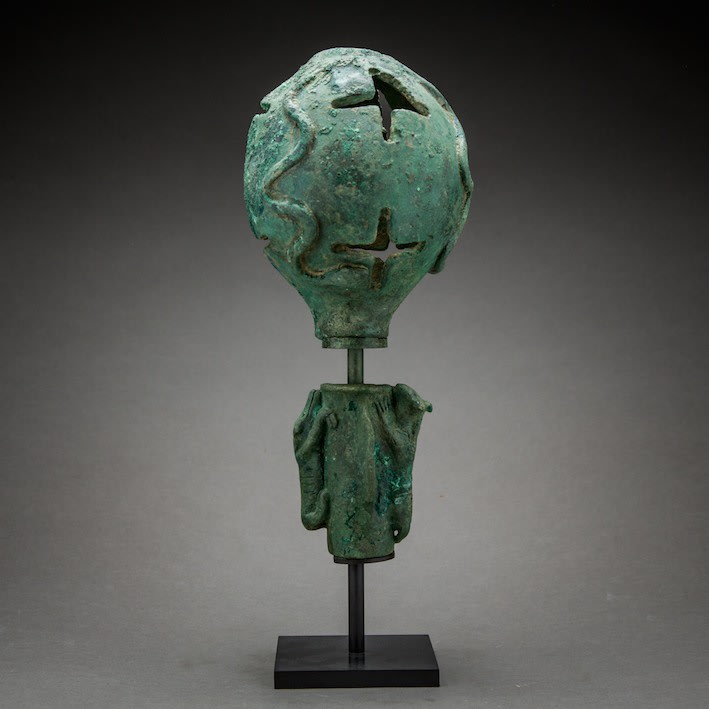Bactria-Margiana Bronze Mace Head, 2500 BCE - 1250 BCE
Bronze
29.2 x 14 cm
11 1/2 x 5 1/2 in
11 1/2 x 5 1/2 in
OF.266
Further images
This piece pertains to an ancient culture referred to both as the Bactria-Margiana Archaeological Complex (BCAM) or as the Oxus Civilisation. The Bactria-Margiana culture spread across an area encompassing the...
This piece pertains to an ancient culture referred to both as the Bactria-Margiana Archaeological Complex (BCAM) or as the Oxus Civilisation. The Bactria-Margiana culture spread across an area encompassing the modern nations of Turkmenistan, Tajikistan, Uzbekistan and Northern Afghanistan. Flourishing between about 2100 and 1700 BC, it was contemporary with the European Bronze Age, and was characterised by monumental architecture, social complexity and extremely distinctive cultural artefacts that vanish from the record a few centuries after they first appear. Pictographs on seals have been argued to indicate an independently-developed writing system.
It was one of many economic and social entities in the vicinity, and was a powerful country due to the exceptional fertility and wealth of its agricultural lands. This in turn gave rise to a complex and multifaceted set of societies with specialist craftsmen who produced luxury materials such as this for the ruling and aristocratic elites. Trade appears to have been important, as Bactrian artefacts appear all over the Persian Gulf as well as in the Iranian Plateau and the Indus Valley. For this reason, the area was fought over from deep prehistory until the Mediaeval period, by the armies of Asia Minor, Greece (Macedonia), India and the Arab States, amongst others.
During the 2nd millennium BC metallurgists in Bactria-Margiana were already fairly well-versed in the bronze casting process, both by mould and lost wax. As an integral part in their artistic production, bronze was used not only for ceremonial and functional axes, but also to create adornments, including pins, pendants and other accessories such as small cosmetic bottles. These bottles have been mostly excavated from burial contexts in Bactria-Margiana; the most interesting examples featuring three-dimensional sculptures of animals.
It was one of many economic and social entities in the vicinity, and was a powerful country due to the exceptional fertility and wealth of its agricultural lands. This in turn gave rise to a complex and multifaceted set of societies with specialist craftsmen who produced luxury materials such as this for the ruling and aristocratic elites. Trade appears to have been important, as Bactrian artefacts appear all over the Persian Gulf as well as in the Iranian Plateau and the Indus Valley. For this reason, the area was fought over from deep prehistory until the Mediaeval period, by the armies of Asia Minor, Greece (Macedonia), India and the Arab States, amongst others.
During the 2nd millennium BC metallurgists in Bactria-Margiana were already fairly well-versed in the bronze casting process, both by mould and lost wax. As an integral part in their artistic production, bronze was used not only for ceremonial and functional axes, but also to create adornments, including pins, pendants and other accessories such as small cosmetic bottles. These bottles have been mostly excavated from burial contexts in Bactria-Margiana; the most interesting examples featuring three-dimensional sculptures of animals.





